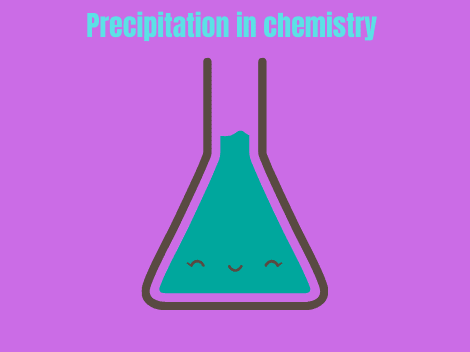
Introduction
A chemical reaction is a reaction that changes the molecular structure of matter resulting in the formation of new matter with one or more different properties. For example, electrolysis of water mixed with a small amount of acid dissolves the water and produces hydrogen and oxygen. Their properties are completely different from the properties of water. The chemical reaction of matter does not happen by itself without a cause. Any chemical reaction is not complete as soon as it starts. It takes some time for the reaction to be completed. Some reactions are completed very quickly, while some reactions take a long time to complete. These reactions are divided into two parts a) Slow reaction and b) Fast reaction. Precipitation is a fast reaction (1) & (2). The following article is about what is precipitation in chemistry and its examples.
Precipitation in Chemistry
In daily life, we see many types of chemical reactions. Some of these reactions we know and some we don’t know. These are burning, corrosion, cooking of food, eating, and much more. Precipitation is one such reaction. In precipitation, products are made by combining two separate solutions in aqueous solutions (1) & (2).
Definition of Precipitation reaction
If one of the matters produced by the chemical reaction of two compounds in a solution is not dissolved in that solution and solidifies as a solid at the bottom of the vessel, it is called the precipitate. The reaction is called precipitation reaction (1) & (2).
Example of Precipitation reaction
1. Adding a silver nitrate solution to an aqueous solution of sodium chloride instantly produces white silver chloride and the solution produces sodium nitrate (1) & (2).
NaCl + AgNO₃ → AgCl ↓ + NaNO₃
Sodium Silver Silver sodium
Chloride nitrate chloride nitrate
2. When Sodium hydroxide is added to the aqueous solution of copper sulfate, the sky-blue Copper hydroxide precipitates in an instant, and Sodium sulfate is produced (1) & (2).
CuSO₄ + 2NaOH → Cu(OH)₂ ↓+ Na₂SO₄
Copper sodium copper sodium
sulfate hydroxide sulfate
Properties of Precipitation reaction
1. Precipitation is a fast chemical reaction.
2. The two reactants participating in this reaction are usually ionic compounds.
3. Whether the compounds produced from the reaction will precipitate depends on the solvent used in the reaction.
4. The compounds produced in this reaction may precipitate in aqueous solution but may not precipitate in any other solvent.
5. This reaction depends on temperature, buffer solution, etc.
6. This reaction takes place in the aqueous solution or medium in the ionic state.
7. This reaction forms the product between the ions present in the aqueous solution.
8. Since the ions actively participate in the reaction and form the product, precipitation is known as an ionic reaction (1) & (2).
A precipitation reaction is a part of the double-displacement reaction
A double displacement reaction is a chemical reaction, where the positive and negative ions of two ionic compounds exchange for the formation of new compounds. In this chemical reaction, a part of two ionic compounds is exchanged and new elements are formed.
here in this reaction, A and C are positively charged cations, and B and D are negatively charged anions.
In most double-displacement reactions, there are two ionic compounds that play a role in the formation of an insoluble product, called a precipitate. The reaction by which an insoluble product is formed from these two ionic compounds is precipitation. So precipitation reaction is a part of the double-displacement reaction.
BaCl₂ + Na₂SO₄ → BaSO₄ + 2NaCl
In this example, the Ba⁺ and Na⁺ are cations, and Cl⁻ and So₄⁻ are anions. If the anions and cations are exchanged the BaSO₄ is precipitate and produces NaCl (1) & (2).
Use of precipitation
These chemical reactions are used for a variety of purposes. The precipitation reaction helps to determine a specific component present in a given solution. When some chemicals are added to this solution, a precipitate structure is observed in these reactions. Magnesium is extracted from seawater by this reaction. This reaction helps to release pollutants from the wastewater. This reaction is used to extract contaminated ions when a contaminant forms an isolated solid (1) & (2).
